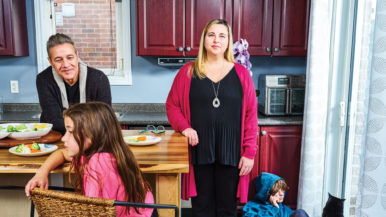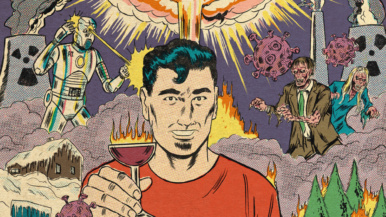Global News figured out where all of Toronto’s sex offenders live

Don’t panic, Liberty Villagers, Parkdalians and Corktownspeople, but listen carefully: your parts of the city are home to above-average concentrations of sex offenders.
For that delightful piece of information, thank Global News, which spent six years battling the provincial government in court in order to get this information released. A map prepared by the news outlet and released on its website earlier today helpfully colour-codes all of Ontario’s postal codes according to the number of registered sex offenders living in each of them, per 100,000 residents.
The darkest spots on Toronto’s section of the map are clustered in the downtown east end, particularly around Regent Park and Moss Park, where 102 registered sex offenders resided as of April 2014. The Junction area, between Runnymede and the train tracks, had 62. Little Portugal and Liberty Village were also punching above their weight, at 58. It can’t be coincidental that all these places have relatively cheap housing and fairly good access to public services.
Anyone thinking about packing up the kids and moving, take note: there are sex offenders living throughout the rest of the city as well, but in lower concentrations. What Global’s map reveals, more than anything else, is that existing side-by-side with criminals and ex-criminals is just an inescapable fact of city life. Most of us will be fine. (Although, interestingly, some of the highest concentrations of sex offenders are way up in northern Ontario.)
Global’s full map and story are here.






Only if they are caught. First timers would not register until they are caught.
with all the gentrification in parkdale and the condo complexes in the liberty village you would think that these neighbourhoods wouldn’t be deemed as “low income” and it might even have to do with the nightlife in those neighbourhoods… I was an unfortunate victim of sexual assault in this city but it happened in the nightlife district of King Street where it is said that a lot of these predators party or camp out… alcohol can make people vulnerable victims but it can also play a large role in impairing the judgement of the offender
Keep in mind this may be where they live, but that doesn’t mean it’s where the actual crimes take place. If you look at a crime map, you’ll see that the areas you’d automatically suspect to be more concentrated with sexual assault crimes are the usual: club district, etc.
It’s important to be aware and take precaution no matter where you live, what gender you happen to be, or how familiar you are with the neighbourhood.
Northern Ontario… Hmmmmm, not surprising..
This article is wrong. The actual 2014 number for the Junction (per the Global map) is 43, not 62. You used 2008 numbers by mistake. Please correct this error.
A child is ~90% likely to be sexually abused by someone they already know closely, most like a family member.
From the analysis of more than 16 studies performed by 7 USA states flowing 56,001 released sex offenders categorically showed the following results, something the government has provably known since at least 1985:
1) The majority of sex offender who commit new sex crimes do so within the first three years after being freed which is why paroles were originally set to 3 years.
2) The risk of a sex offender committing a new sex crime decreases the longer an offender remains free without committing any new sex crime.
3) Combining these studies in a (weighted by # of sex offenders) average results in a risk of committing a new sex crime of approximately 4.0%*exp(-0.45*t), where “t” is the time from release back into society, i.e. from release from prison, jail, custody. This works out to:
3.a) ~4.00% risk to commit new sex crime from time of release.
3.b) ~2.55% risk to commit new sex crime after 1 year of not committing a new sex crime.
3.c) ~1.63% risk to commit new sex crime after 2 years of not committing a new sex crime.
3.d) ~1.04% risk to commit new sex crime after 3 year of not committing a new sex crime, the length of a standard 3 year parole.
4) These statistics are true taking into account all sex offenders, however, when divided into groups of those who rape adults versus those who sexually molest children, the adult rapists were about twice as likely to re-offend with new sex crimes.
5) That from these studies most likely 96% of sex offenders will never re-offend with a new sex crime. Using a generous margin of error, at worst case 90% of sex offenders will never re-offend with a new sex crime; while at best case 98.7% of sex offenders will never re-offend with a new sex crime.
It is also worth realizing that:
~3.97% of sex offenders are age 7 to 11 years
~20.57% of sex offenders are age 12 to 17 years
combined ~24.54% of sex offenders are age 7 to 17 years
~8.09% of sex offenders are age 18 to 20 years
~7.43% of sex offenders are age 21 to 24
combined ~40.06% of sex offenders are age 7 to 24
Studying psychology shows that it is not unusual for people to be developing their sexual identities beginning as young as around 7 and still working on figuring it out by around 24, particularly in a sexually repressive society where individuals often have no social sexual experience until they are well into their twenties. Such sexual experimentation usually tests the boundaries of what is socially acceptable as the developing person settles into a sexual identity which typically lasts the rest of their life, but is well within socially acceptable norms.
Making people social pariahs for life, giving them significantly less rights than would normally be granted any Human being, effectively trashing the Constitution of the U.S. when it comes to sex offenders when the above statistical facts are known and provable by the government is wrong.